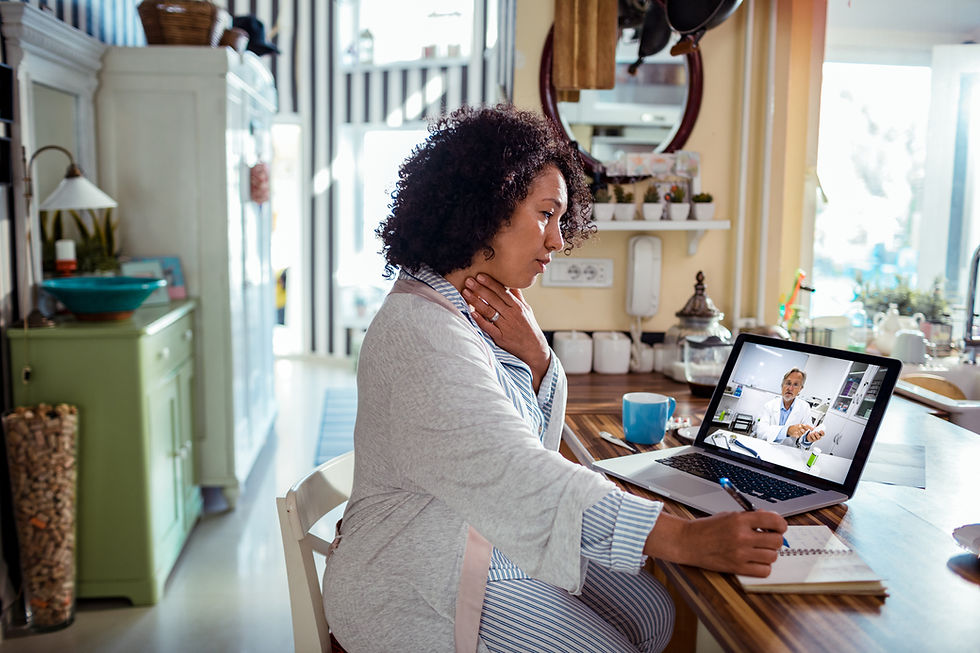Is Virtual Health Care Good Enough? What Patients Should Know
- Zach Walston

- Apr 29
- 4 min read

Virtual health care is becoming more common, and many people are asking an important question: Can it really replace seeing a doctor in person?
As a physical therapist, I use virtual care often—but not to replace in-person care. I use it to help people who might not be able to come into a clinic. Some people have busy work or school schedules, or they’re taking care of their family. For them, virtual visits can be a great option.
Many People Don’t Have Easy Access to Care
A recent report from GoodRx showed that many parts of the U.S. don’t have the health care people need. These areas are called “healthcare deserts.” That means they don’t have enough doctors, pharmacies, hospitals, or low-cost clinics. Here’s what they found:
Over 80% of U.S. counties are missing at least one important type of care.
40% are pharmacy deserts.
9% don’t have enough primary care doctors.
20% are hospital deserts.
45% don’t have nearby low-cost clinics.
Virtual care can help people in these areas, but it’s not perfect. Some people don’t have fast internet or even internet at all. Reports show that between 14 to 42 million people in the U.S. don’t have reliable internet access, especially in rural or tribal areas.
So, while virtual care can be helpful, we still need better technology and internet access to make it work for everyone.
Types of Virtual Health Care
There are lots of ways to get help through virtual care. Here are some common ones:
Telehealth
This is when you talk to a doctor or therapist by phone or video. You can ask questions, get a diagnosis, and make a treatment plan without going to a clinic. During COVID-19, these visits went way up—from 5 million to 53 million Medicare visits in one year!
Chat
Some apps let you chat with dietitians, health coaches, or other providers. It’s a fast way to ask questions and get advice.
Remote Therapeutic Monitoring (RTM)
This is when a doctor or therapist uses technology (like apps or wearable devices) to check on your health while you’re at home. You can track symptoms or send updates about your progress.
Digital Health Programs
Some programs let you watch videos, read articles, or do exercises at your own pace. For example, there are self-care plans for back pain or weight loss that you can do from your phone or computer.
Does Virtual Care Work?
Virtual care can’t replace emergency rooms or surgeries. But it can be helpful for follow-ups, mental health, pain management, and more.
Urgent Care
One study looked at over 16,000 urgent care visits. It found that virtual visits were:
Shorter (about 9 minutes vs. 70 minutes in person)
Cheaper ($49 vs. $142)
Virtual urgent care also helped patients get answers faster and avoid long wait times.
Family Medicine
A big review of 30 studies found that virtual visits were just as helpful as in-person ones for things like:
Mental health
Quitting smoking
Reducing alcohol use
Virtual visits saved time and money but didn’t always feel as “personal.”
Surgery Follow-Ups
For people who had low-risk surgeries, virtual check-ins after surgery worked just as well and made patients happy.
Physical Therapy (PT)
Virtual PT can work really well when a physical therapist guides the care. A big review found that people with muscle or joint pain saw real improvements. It also showed that switching just 25% of back pain patients to virtual PT could save millions of dollars.
Do Patients Like It?
Yes, in many cases! One survey found:
90% of people would recommend telemedicine after trying it.
62% said they’re more likely to get care if it’s virtual.
44% still felt in-person care was more effective.
75% thought virtual care should be cheaper.
Most people liked their doctor just as much (or more) after a virtual visit. But they didn’t always love the tech—like setting up calls or apps.
How to Use Virtual Care in Your Life
Virtual care works best when it’s part of a mix of in-person and online care. Here’s how to make it work for you:
1. Start with a Virtual Triage
A quick video or phone call can help a provider decide what kind of care you need.
2. Go In Person When Needed
Sometimes, you’ll need a hands-on visit—especially for things like physical exams or pain that’s hard to explain online.
3. Get the Right Tools
Make sure you have a good internet connection, a device with a camera, and space if you need to do exercises.
4. Keep Talking to Your Provider
Let them know how things are going. They can make changes to your plan if needed.
5. Use a Combo Plan
If you’re doing physical therapy, you might start in person, then switch to virtual check-ins. This saves time and keeps you on track.
Final Thoughts
Virtual care isn’t perfect, but it’s a powerful tool. It helps people get care who might not be able to visit a clinic. And when used the right way—with a mix of in-person visits—it can lead to great results.
As virtual care keeps growing, you’ll have more ways to take control of your health in a way that fits your life. That’s a win for everyone.




Comments